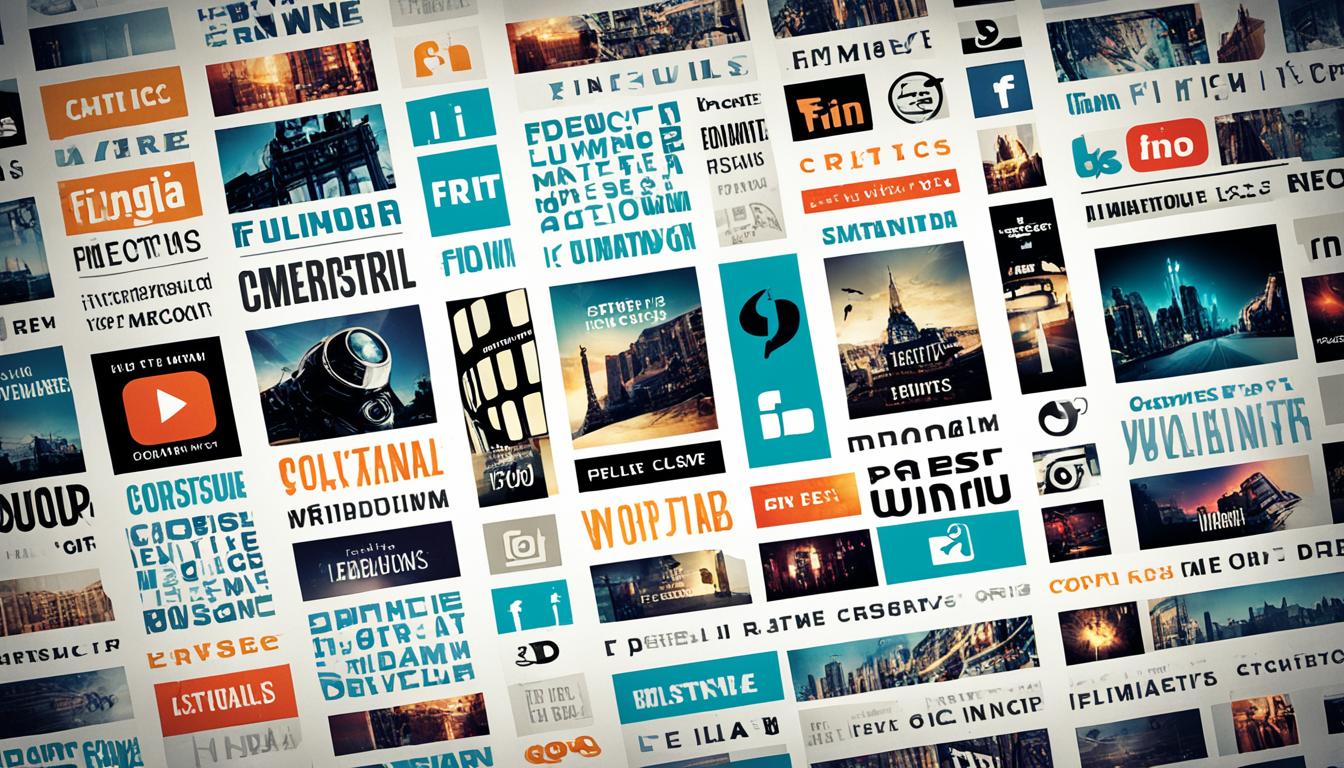Digital Out-of-Home (DOOH) advertising has changed how brands meet audiences outside. It uses eye-catching and lively methods, making DOOH a strong tool for marketers. This type involves digital billboards and bus-stop screens, opening new ways to engage with people.
DOOH lets advertisers update content on screens from afar. This ensures messages are current and fit the audience’s location and interests. With DOOH, businesses can effectively target and influence their ideal customers.
In this article, we’ll dive into DOOH advertising. We’ll look at successful DOOH campaigns and see how they differ from traditional ads. We’ll cover DOOH’s benefits and the rise of programmatic DOOH. Plus, we’ll check out the major DOOH trends for 2022.
Key Takeaways:
- Digital Out-of-Home (DOOH) advertising displays dynamic promotional media in public spaces.
- DOOH campaigns offer real-time updates and tailored messaging based on location and audience demographics.
- Examples of DOOH advertising include digital billboards, bus-stop displays, and elevator screens.
- DOOH provides advantages such as extensive outreach, higher interaction, and better measurement.
- Programmatic DOOH streamlines campaign management and improves audience targeting.
What is DOOH Advertising?
DOOH advertising stands for Digital Out-of-Home Advertising. It’s a way to show ads in public places using digital screens. This method uses billboards, menu boards, and transit screens to grab people’s attention.
With DOOH, advertisers can change their ads based on where and when they’re shown. This is thanks to technology. Now, they can update ads in real-time and keep content interesting.
Because of digital tech, ads can be changed quickly to fit the right audience. Advertisers manage ads from afar, making sure they’re always current and striking.
DOOH ads are everywhere. They’re on busy streets, in transit spots, and in restaurants. These ads help brands reach people in many places.
Advantages of DOOH Advertising:
- Greater control over content distribution and customization
- Real-time updates for timely and relevant messaging
- Engaging content that captivates audiences
- Opportunities for targeted advertising based on location and demographics
- Enhanced brand visibility in high-traffic areas
DOOH advertising is a strong tool in today’s digital world. It helps brands make an impact in real places. By using DOOH, advertisers can deliver powerful ads that get noticed and drive action.
| Traditional Outdoor Advertising | DOOH Advertising |
|---|---|
| Limited control over content and messaging | Greater control over content distribution and customization |
| Static and non-interactive displays | Dynamic and engaging content that captivates audiences |
| Difficult to measure campaign performance | Access to analytics for measuring campaign effectiveness |
Table: A comparison between traditional outdoor advertising and DOOH advertising.
Examples of DOOH Advertising
Here are five compelling examples of digital out-of-home (DOOH) advertising. They show how effective and versatile it is:
-
Digital Billboards
These displays are huge and have high-res screens. They grab people’s attention in busy places. With technologies like 3D visuals, they offer a memorable experience.
-
Bus-stop DOOH Advertising
At bus stops, interactive campaigns keep commuters entertained. They use technologies like augmented reality for an engaging experience.
-
Footpath DOOH
Digital posters along footpaths catch pedestrians’ eyes. Their bright displays show quick ads, reaching many people effectively.
-
Car-top DOOH
Digital screens on vehicles reach lots of viewers. They use location-based targeting to show ads in relevant spots, making a big impact.
-
Elevator DOOH Screens
Displays in elevators grab people’s attention during downtime. Elevator DOOH screens make dynamic and interactive campaigns possible.
-
Gas Station Digital Advertisements
At gas stations, digital screens catch customers’ eyes. They show timely ads, making them great for targeted marketing.
Traditional vs. DOOH Advertising
Digital Out-of-Home (DOOH) advertising is a strong choice next to traditional outdoor ads. It has many benefits that catch marketers’ interest:
Real-time updates
DOOH advertising’s big win is its real-time updates. Digital displays change fast with new info. This means ads can quickly adjust to new offers or news. Timely content keeps brands fresh and draws in viewers.
Extensive outreach
DOOH ads reach lots of people in busy places. They’re seen in places like malls, airports, and bus stations. This spreads the brand wide, making more people notice and remember it.
Higher interaction
DOOH ads are great at pulling viewers in with interactive features. Things like touchscreens and motion sensors make ads people can dive into. This deepens the bond between people and brands, making ads more memorable.
Analytics
DOOH advertising’s bonus is its tracking and data analysis. Marketers learn lots about how people react to their ads. This helps improve ads over time, making sure they hit the mark.
In summary, DOOH advertising beats traditional ads in many ways. It’s up-to-date, wide-reaching, engaging, and it’s smart with its data. For marketers wanting to stand out, DOOH is the way to go.
Key Advantages of DOOH Advertising
DOOH advertising has many benefits. It’s a strong way to reach people in public places. Here are its main strengths:
-
Flexibility and Customization
DOOH makes updating ads easy based on the audience or the weather. Brands can change their messages to fit the situation. This ensures ads are on target and powerful.
-
Connectivity
DOOH connects well with smartphones and smart devices. This blend lets advertisers link outdoor ads with online ones. It offers users a smooth and engaging brand story.
-
Better Measurement
DOOH offers detailed data tracking. This lets advertisers see how well their ads are doing. With this data, they can make better planning decisions and use their budgets wisely.
-
Rich Media Opportunities
DOOH supports lively video and interactive content. This helps brands captivate audiences. It makes ads more memorable, boosting brand awareness.
-
Cost-effectiveness
DOOH cuts out print ad costs. It also allows for budget-friendly options. By choosing specific locations and times, brands can get more for their money.
DOOH advertising stands out as an efficient marketing choice. It lets brands share their stories in a compelling way in busy public spots.
What is Programmatic DOOH (pDOOH) Advertising?
Programmatic DOOH (pDOOH) advertising automates ad buying and selling. It uses technology to enable quick, flexible, and targeted ad placements. With pDOOH, advertisers can tweak campaigns in real time, change ads quickly, and fit into the broader digital ad world. This method cuts out manual ad space negotiation, bringing better prices and efficiency.
The introduction of programmatic DOOH transforms DOOH media buying. It uses tech and data to send personalized ad messages directly to the target audience. This makes buying and selling ad space quicker and cheaper. It allows advertisers to adjust their strategies based on how their ads are performing.
Programmatic DOOH’s speed and efficiency stand out. Advertisers can promptly buy ad spots in real-time, avoiding delays. This means their ads get shown exactly when they need to be. Such flexibility is key for targeting events, holidays, or any urgent marketing opportunities.
Programmatic DOOH also brings flexibility in choosing and changing ads. With up-to-the-minute data, advertisers can make ads that speak to specific groups of people. This helps create ads that truly connect with viewers, based on what they like and do.
Moreover, programmatic DOOH integrates well with other digital ads. This connection helps advertisers reach people across different platforms. By doing this, brands can ensure their messages stay consistent and can also retarget ads, making every step of the customer’s online journey engaging.
Advantages of Programmatic DOOH Advertising:
- Real-time campaign optimization: With Programmatic DOOH, advertisers can quickly change their ads based on data. This means they can always be sure their ads are working as well as possible.
- Enhanced audience targeting: By tying into bigger ad platforms, programmatic DOOH helps aim ads more precisely. This sharp targeting means ads can catch more interest and lead to more action from viewers.
- Transparent and fair marketplace: Real-time bidding makes pricing for ad space open and fair. This transparency builds trust between advertisers, leading to better campaigns.
- Dynamic and personalized creatives: Programmatic DOOH lets advertisers use data like weather or location to make relevant ads. This makes ads more engaging to specific audiences.
Programmatic DOOH advertising changes how ads are bought and shown in the digital age. Its automation, quick bidding, and smart targeting unlock new possibilities. This leads to more effective campaigns and stronger brand connections.
| Advantages of Programmatic DOOH Advertising | Description |
|---|---|
| Real-time campaign optimization | Adapt and optimize campaigns on-the-fly based on real-time data and insights. |
| Enhanced audience targeting | Leverage sophisticated targeting capabilities to reach the desired audience with precision. |
| Transparent and fair marketplace | Eliminate price-fixing and ensure fair pricing for ad space. |
| Dynamic and personalized creatives | Create contextual and relevant ads using real-time data. |
Key Advantages of Programmatic DOOH
Programmatic DOOH (pDOOH) brings many benefits for advertisers. They can fine-tune their campaigns, target audiences more effectively, and get better outcomes. Here’s a closer look at what pDOOH offers:
- Campaign Optimization: Programmatic DOOH lets advertisers change their creatives, targeting, and budget on the fly. This means they can adjust quickly to ensure their ads reach the right people when it matters most.
- Audience Targeting: pDOOH connects with bigger ad systems for sharper audience targeting. Advertisers can use detailed data to make ads more personal. This increases engagement and boosts brand connection.
- Real-time Bidding: Programmatic DOOH cuts out set prices and haggling. This creates a fair, open market. Advertisers can bid in real-time, aiming for the best ad spots without overspending.
- Dynamic Creative Display: Advertisers can change ads based on location, weather, or who’s watching. This makes ads more relevant and engaging, lifting their impact.
On the whole, programmatic DOOH lets advertisers refine their campaigns and target audiences more sharply. It removes fixed pricing and brings ads to life in new, impactful ways. This makes pDOOH a powerful tool for anyone looking to up their advertising game.
Top DOOH Trends in 2022
Digital out-of-home advertising (DOOH) is changing fast in 2022. Several trends are guiding this change. Marketers need to understand and use these trends to lead.
Data-driven campaigns
Data-driven campaigns are big in DOOH this year. Thanks to tech and analytics, ads can be optimized using real-time data. Marketers can now target their audiences better. This improves campaign success.
By using data, advertisers understand people’s likes and habits better. This helps in creating messages that really speak to viewers. It’s a smart way to increase returns on their investments.
Increased interactivity
Interactivity is growing in DOOH. Ads now have touchscreens, gesture recognition, and even AR. This makes ads more engaging and fun.
Interactive ads grab attention and make audiences remember brands better. They also offer a fresh and unforgettable experience. Plus, they give valuable data on what customers like and do.
Integration with mobile
DOOH is teaming up with mobile devices, offering cross-channel campaigns and retargeting. This makes a smooth link between outdoor and online ads. It’s a strategy that makes your brand’s message stronger across many platforms.
This way, brands can also reach people on their phones right after they’ve seen an outdoor ad. It helps reinforce the ad’s message and encourages action.
Programmatic DOOH growth
Programmatic DOOH is getting more popular. It uses tech for automated ad buying and selling. This means ads are more targeted, and campaigns are easier to manage. It’s a smarter way to advertise.
Programmatic DOOH makes it simple to change ads quickly and make sure they reach the right audience. It represents a new level of efficiency in managing campaigns.
These trends are steering DOOH in 2022. As tech grows and people’s habits change, using these trends is key. They help brands stand out and achieve better results.
Conclusion
Digital Out-of-Home Advertising (DOOH) is getting more popular and works well in public spaces. Brands can update their ads in real-time and reach a lot of people. Programmatic DOOH makes these campaigns even better by targeting the right audiences.
To keep up, marketers need to know the latest trends and technologies. They should use data to make ads more interactive and connect them with mobile devices. Staying updated with DOOH trends is key to success.
DOOH advertising helps brands share their message in a big way. It grabs people’s attention in busy places and shows ads that speak to them. By using the newest DOOH trends and technologies, marketers can make their ads more powerful. This helps them get noticed in a world full of digital ads.





